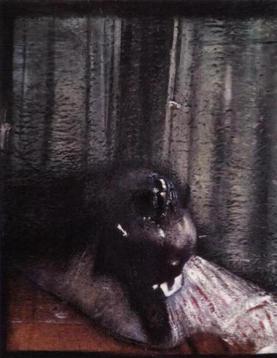Top Qs
Timeline
Chat
Perspective
Head II
Painting by Francis Bacon From Wikipedia, the free encyclopedia
Remove ads
Head II is an oil and tempera on hardboard painting by the Irish-born British figurative artist Francis Bacon. Completed in 1948, it is the second in a series of six heads, painted from the winter of 1948 in preparation for a November 1949 exhibition at the Hanover Gallery, London.[1]
The figure seems half human, half animal, and has disintegrated to an extent that, like the preceding Head I of the series, the entire upper head has disappeared, leaving only mouth and jaw. The figure is set in a shallow pictorial space, and is positioned behind curtains that borrow from Titian's 1558 Portrait of Cardinal Filippo Archinto. The curtains are fastened at one point by a safety pin. John Russell sees the curtains as enclosing the figure, as if the walls of a prison or execution dock. Remarking on their dreary and drab appearance, he further speculates that they seem "stiffened by fifty years' crassness of a tenth-rate lodging-house; or they could be sliding shutters that have been pulled apart to admit a new victim."[2]
The painting's overall grisaille appearance gives the impression of x-ray photographs, and K.C. Clark's Positioning may have inspired the look in Radiography, a book Bacon often acknowledged as a key source for his work. The painting contains a small arrow just below the figure's mouth; the first appearance of a motif the artist was to continue using for the rest of his career.[3]
Remove ads
See also
Notes
Sources
Wikiwand - on
Seamless Wikipedia browsing. On steroids.
Remove ads

